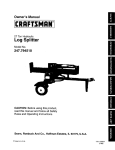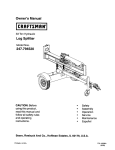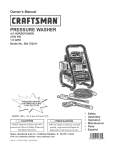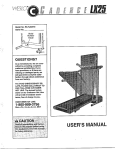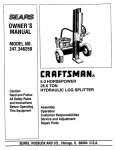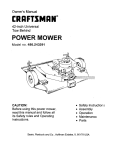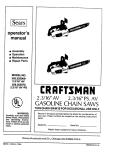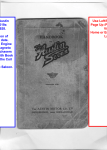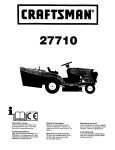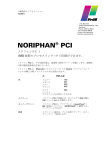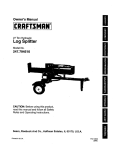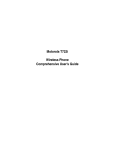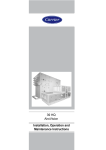Download Champion 22 TON LOG SPLITTER Owner`s manual
Transcript
/ Owner's Manual [I:RR / / 22 Ton Hydraulic Log Splitter Model No. 247.794500 Ii I! CAUTION: Before using this product, read this manual and follow all Safety Rules and Operating Instructions. Sears, Roebuck And Co., Hoffman Estates, IL 60179, U.S.A. Printed in U.S.A. 770-10035A (7/99) / U Content Page Content Page Warranty Information......................................... 2 Maintenance ...................................................... 14 Safe Operation Practices ................................... 3 Service & Adjustment ........................................ 17 Accessories ....................................................... 7 Off-Season Storage ........................................... 19 Assembly ........................................................... 8 Trouble-Shooting............................................... 20 Operation ........................................................... 10 Parts List............................................................ 22 ONE-YEAR WARRANTY ON CRAFTSMAN LOG SPLITTER For one year from the date of purchase, when this Craftsman log splitter is maintained, lubricated, and tuned up according to the operating and maintenance instructions in the operator's manual, Sears will repair, free of charge, any defect in material or workmanship. This warranty excludes the tires, spark plug, oil filter and air cleaner, which are expendable parts and become worn during normal use. If this log splitter is used for commercial or rental purposes, this warranty applies for only 30 days from the date of purchase. WARRANTY SERVICE IS AVAILABLE BY CONTACTING THE NEAREST SEARS SERVICE CENTER IN THE UNITED STATES. THIS WARRANTY APPLIES ONLY WHILE THIS PRODUCT IS IN USE IN THE UNITED STATES. This warranty gives you specific legal rights, and you may also have other rights which vary from state to state. Sears, Roebuck and Co., Dept. 817WA, Hoffman Estates, IL 60179 Horsepower: ......................... 5.0 Engine Oil .............................. SAE 30/1.25 pints Fuel Capacity: ....................... unleaded/1.25 qts. Hydraulic Fluid ...................... Dexron III/4 gallons Tire Pressure ......................... 30 p.s.i, maximum Spark Plug (Gap .030") .......... Champion RJI9LM Magnetron Ignition Air Gap.....0125" Model Number..2..4,7.:7..9.4..5.0,0. ................................... Serial Number ........................................................... Date of Purchase ...................................................... Record model number, serial number and date of purchase of the log splitter and keep in a safe place for future reference. Thissymbol points out important safety instructions which, if not followed,could endangerthe personalsafety and/or propertyof youmelfand others. Read and follow all instructionsin this manualbefore attempting to operateyour logsplitter.Failureto complywith these instructions may resultin personal injury. When you see this symbol--heed its warning. Your log splitter was built to be operated according to the rules for safe operation In this manual, As with any type of power equipment, carelessness or error on the part of the operator can result in serious injury, if you violate any of these rules, y_u may cause serious injury to yourself or others, The engine exhaust from this product contains chemicals known to the state of California to cause cancer, birthdefects or other reproductive harm. Towing • • • • • • • • • This unit should not be towed on any street, highway or publicroad without checking the existing federal, local or state requirements. Such information may be obtained by calling your state or local bureau of motor vehicles. Any licensing or modificationsneeded to comply with federal, local or state vehicle requirements is the sole responsibilityof the purchaser. Make sure you follow the wiring diagram color codes when installing the light kit on the log splitter. (e.g. ground to ground, left turn to left turn, etc.). Failure to wire unit correctly may cause the tow vehicle wiring to overheat and/or the log splitter lights to operate incorrectly. It may be necessary to replace the turn signal flasher unit in your tow vehicle if it is not capable of operating the additional lights on the log splitter. Before towing the log splitter on a street, highway or public road, verify that all lights are functioning properly and the yellow side reflectors are in position. Replace bulbs if they are burnt out. Before towing, always check to be certain the log splitter is correctly and securely attached to the tow vehicle, and safety chains are in place. Leave slack in chains for turning allowance. Use a class I or higher hitch with a 1-7/8" ball. Keep ball socket and clamp face lubricated with chassis grease. Be sure the coupler is secured to the hitch ball and the lock lever is down tight and locked. Check vehicle hitch, ball and coupler for signs of wear or damage. Replace any parts that are worn or damaged before towing. The coupler must be secured to the log splitter tongue tube with the original equipment bolts and nuts. See your authorized service dealer for replacement parts. Coupler nuts should be tightened securely (20 foot pounds). Make sure beam assembly is securely latched in • • • • the horizontal position and jack stand (if provided) is pivoted and secured in the up position before towing log splitter, Never tow with the beam in vertical position. Do not tow the log splitter faster than 45 MPH. Higher speeds may damage log splitter. Excessive high speeds may cause the logsplitter to =fishtail" or otherwise become unstable. Check the tire pressure on the log splitter tires. It must be 30 p.s.i. MAXIMUM for highway travel. When parking, storing or using your logsplitter, keep the coupler off the ground so dirtwill not build up in the ball socket. Do not allow anyone to sit or ride on your log splitter. They can easily fall off and be seriously injured. Training • • • • 3 Before operating this log splitter, read and understand this operator's manual completely. Become familiar with itfor your own safety. To fail to do so may cause serious injury. Do not allow anyone to operate your log splitter who has not read this manual. Keep this manual in a safe place for future and regular reference and for ordering replacement parts. Never use your splitter for any other purpose than splitting wood. It is designed for this use and any other use may cause an injury. Your log splitter is a precision piece of power equipment, not a toy. Therefore, exercise extreme caution at all times. Never arrow children to operate your log splitter. Do not allow adults to operate it without proper instruction.Only persons well acquainted with these rules of safe operation should be allowed to use your log splitter. Only the operator is to be near your log splitter during use. Keep all others, including pets and children, a minimum of 20 feet away from your work zone. Flying wood can be hazardous. If a helper is assisting in loading logs, never activate the control until the helper is clear of the area, More accidents occur when more than one person operates the log splitter than at any other time. No one should operate this unit while intoxicated or while taking medication that impairs the senses or reactions. A clear mind is essential for Horizontal Operating Position: Stand behind the reservoirtank. See illustrations. safety. Never allow a person who is tired or otherwise not alert to use your log splitter. Preparation • • • • • • • • • • • • • Never wear loose clothing or jewelry that can be caught by moving parts of your log splitter and pull you into it. Keep clothing away from all moving parts of your log splitter. Wear proper head gear to keep hair away from moving parts. Always wear protective hearing devices as needed. Always wear safety shoes. A dropped log can seriously injure your foot. Always wear safety glasses or goggles while operating your splitter. A piece of splittinglog could fly off and hit your eyes. Wear leather work gloves. Be sure they are tight fitting without loose cuffsor draw strings. Use your log splitter in daylight, or under good artificial light. Never operate your splitter on slippery, wet, muddy or icy surfaces. Safe footing is essential in preventing accidents, Never operate your splitter while attached to a towing vehicle. Only operate your splitter on level ground and not on the side of a hill. It could tip, or rolling logs or poor footing could cause an accident. Operating the splitter on level ground also prevents the spillage of gasoline from the fuel tank. Never attempt to move the log splitter over hilly or uneven terrain without a tow vehicle or adequate help. Always block the wheels to prevent movement of log splitter while in operation. Check the fuel before starting the engine. Gasoline is an extremely flammable fuel. Do not fill the gasoline tank indoors, when the engine is running, or while the engine is still hot. Replace gasoline cap securely and wipe off any spilled gasoline before starting the engine as it may cause a fire or explosion. Both ends of each log must be cut as square as possible to help prevent the log from riding out of the splitter during operation. Operation • Vertical Operating Position: Stand in front of the logsplitter. Know how to stop the unit and disengage the controls. Never place hands or feet between log and splittingwedge or between log and end plate during forward or reverse stroke. To do so may result in crushed or amputated fingers or toes, or worse, you may lose an arm or foot. Do not straddle the splitter when using it. A slip in any position could result in a serious injury. Do not step over your log splitter when the engine is running. You may trip or accidentally activate the splittingwedge if you step over. If you need to get to the other side, walk around. Never try to split two logs on top of each other. One may fly out and injure you. When loading the log splitter, place your hands on the side of the log, not at the ends. Never attempt to load your splitter while the splitting wedge is in motion. You may get caught by the wedge and injured, Only use your hand to operate the splitting wedge or control lever, Never use your foot or a rope or any other extension device. This could result in your inability to stop your splitter quickly enough to avoid injury. Always keep fingers away from any cracks that open in the log during splitting operation. They can quickly close and pinch or amputate your fingers. • • • • • • • • • Never attempt to split woods across the grain. Some types of wood may burst or fly out of your splitter and result in injuryto you or a bystander. For logsthat are not cut square, the longest portion of the log should be rotated down and the most square end placed against the splitting wedge. Keep your work area clean. Immediately remove split wood around your splitter so that you do not stumble over it. Clean chips and dirt off end plate (wood platform) after each log is split, or whenever necessary to maintain flat contact between wood and end plate (platform). Never move the tog splitter while the engine is running. Never leave your log splitter unattended with the engine running. Shut off the engine if you are leaving your splitter,even for a short period of time. Someone could accidentally activate the splittingwedge and be injured. Do not run engine in an enclosed area. Exhaust gases contain carbon monoxide. This odorless gas can be deadly when inhaled. Be careful not to touch the mufflerafter the engine has been running. It will be HOT! If the equipment should start to vibrate abnormally, stop the engine and check immediately for the cause. Vibration is generally a warning of trouble. When cleaning, repairing or inspecting, make certain all moving parts have stopped. Disconnect the spark plug wire and keep the wire away from the plug to prevent accidental starting. Customer • • • • • • • • • • • • • Responsibilities • Do not operate your splitter in poor mechanical conditionor when in need of repair, Periodically check that all nuts, bolts, screws, hose clamps and hydraulicfittings are tightto be sure equipment is in safe working condition. Where appropriate, check all safety guards and shields to be sure they are in the proper position. Never operate your splitter with safety guards, shields or other protective features removed. These safety devices are for your protection. Replace all damaged or worn parts such as hydraulic hoses and fittings immediately with manufacturer approved replacement parts. Do not change the engine governor settings or overspeed the engine. This increases the hazard of personal injury. The maximum engine speed is preset by the manufacturer and is within safety limits. Do not alter your log splitter in any manner such as attaching a rope or extension to the control lever or adding to the width or height of the • • • wedge. Such alterations may cause your splitter to be unsafe. Perform all recommended maintenance procedures before you use your splitter. Do not service or repair your log splitter without disconnectingthe spark plug wire and moving it away from the spark plug. Never store the equipment with gasoline in the tank inside of a buildingwhere ignitionsources are present, such as hot water and space heaters, clothes dryers and the like. Allow the engine to cool before storing in any enclosure. Always store gasoline in an approved, tightly sealed container. Store the container in a cool, dry place. Do not store in a building where ignitionsources are present. To reduce fire hazard, keep engine free of grass, leaves, wood chips, and excessive grease and oil. The hydraulicsystem of your logsplitter requires careful inspection,along with the mechanical parts. Be sure to replace frayed, kinked, or otherwise damaged hydraulic components. Fluid escaping from a very small hole can be almost invisible. Do not check for leaks with your hand. Escaping fluid under pressure can have sufficientforce to penetrate skin, causing serious personal injury. Leaks can be located by passing a piece of cardboard or wood over the suspected leak and looking for discoloration. Should it become necessary to loosen or remove any hydraulic fitting or line, be sure to relieve all pressure by shuttingoff the engine and moving the control handle back and forth several times. Do not remove the cap from the hydraulic tank or reservoirwhile your log splitter is running. Hot oil under pressure could cause injury. The pressure relief valve on your splitter is preset at the factory. Do not adjust the valve. Only a qualified service technician should perform this adjustment. Completely drain fuel tank priorto storage. This guards against accumulation of fuel fumes which could result in a fire hazard. Never store log splitter outside without a waterproof cover. Rain will cause rust on the inside of the cylinder. Important Information Always: • • • • 5 Use clean fluid and check fluid level regularly. Use Dexron III Automatic Transmission Fluid or 10W non-foaming hydraulic fluid. Use a filter (clean or replace regularly). Use a breather cap on fluid reservoir. • • • • • • • • Make certain pump is mounted and aligned properly. Use a flexible "spider" type coupling between engine and pump drive shafts. Keep hoses clear and unblocked. Bleed air out of hoses before operating. Flush and clean hydraulic system before startup after any malfunction or servicing. Use "pipe dope" on all hydraulic fittings. Allow time for warm-up before splittingwood, Prime the pump before initialstart-up by turning over the engine with spark plug disconnected. • Split wood with the grain (lengthwise) only. Never: • • • • • • • • Use when fluid is below 20 ° F, or above 150° F, Use a solid engine/pump coupling. Force pump when mounting. Operate through relief valve. Attempt to adjust unloading or relief valve. settings without pressure gauges. Operate with air in hydraulic system. Use Teflon tape on hydraulicfittings. Attempt to cut wood across the grain, Theseaccessories wereavailable when the log splitter was purchased. These are also available at most Sears retail outlets, catalog and service centers. Most Sears stores can order repair parts for you when you provide the model number of your log splitter. Gasoline Can -<_Fender Tailight Kit IMPORTANT: This unit is shipped without gasoline in the engine. After assembly, see OPERATION section of this manual for proper fuel fill-up. • Tools and Other Items Required • 1. 2. 3. 4. 5. 6. 7. Crowbar or Large Screwdriver A pair of 9/16" Wrenches or a set of Adjustable Wrenches Screwdriver Cutters Remove the two bolts, lock washers and hex nuts that secure the tongue assembly to the beam assembly. See Figure 2. Unlockthe two beam locks by pullingout on the beam locks and pivotingthem down. Remove the tongue assembly. Tongue Assembly Engine Oil for lubricating beam (equipment is shipped with engine oil in the engine for starting) Unleaded Gasoline Dexron III Automatic Transmission Fluid or 10W Beam Non-Foaming Hydraulic Fluid (approximately 4 gallons) Unpacking from Crate WARNING: Exercise extreme caution as parts are very heavy. Mechanical handling equipment or sufficient manpower should be used to prevent injury. • • • Pry the top, sides and ends off crate using a crowbar or large screwdriver. Set panels aside to avoid tire punctures or personal injury. Remove and discard plastic bag that covers unit. Lock Washers and Hex Nuts Figure 2 Note: Do not remove the banding from around the tank until the log splitter is assembled. Disconnecting • Place the end of the tongue assembly in between the brackets on the wheel and reservoir tank assembly. Secure with hardware removed eadier. See Figure 3. Spark Plug Before you proceed with the assembly procedure, disconnectthe spark plug wire from the spark plug on the log splitter engine and move the wire away from the spark plug. This will prevent accidental starting. See Figure 1. Bracket Tongue Nuts Disconnect spark plug wire here Bolts Lock Figure 1 Setting Up Log Splitter NOTE: All hardware needed for assembling your Craftsman log splitter has been placed in position on the equipment. Figure 3 Remove the spring clipand the clevis pin from the jack stand. Pivot the jack stand to the 8 operating position (90°), and secure with the spring clip and clevis pin. See Figure 4. Final Assembly Tire Pressure The tires may have been over-inflated for shipping purposes. Maximum tire pressure should not exceed 30 p.s.i. Check tire pressure regularly. Tongue Preparing the Engine • • • Place the log splitter on a firm, level surface. Check engine oil as instructed on page 11. Fill engine with gasoline as instructedon page 11. Preparing the Log Splitter • Jack Stand • Lubricate the beam area where the splitting wedge will slide with engine oil (do not use grease). Make certain to oil both front and back of the beam face. Remove reservoir vent plug. See Figure 6. Figure 4 • • • • Cut the two straps from around the reservoir tank assembly Remove lag screw and washer which secures the beam assembly to the bottom of the crate. Lower the beam assembly to its horizontal position. Make certain the beam is locked securely with the horizontal beam lock. See Figure 5. Puilthelogsplitteroffthepallet. Fill hydraulic Reservoir Tank Reservoir Vent Plug Figure 6 • \ \ \ \ \ \ \\\_^ Vent Plu • \ \ • • • • • Beam Lock ,/ • Fill the reservoir tank to about 2" from the top with 4 gallons of Dexron III automatic transmission fluid, or lOW non-foaming hydraulic fluid. Replace vent plug securely Disconnect the spark plug wire. Prime the pump by pulling the recoil starter as far as it will go. Repeat approximately 10 times. Reconnect the spark plug wire and start engine. Refer to starting instructions on page 12. Use control handle to engage the wedge to the far extended position. Refer to Figure 8. Retract the wedge. Refilltanktowithin 1-1/2"to2"fromthetopof the tank. Extendandretractthewedge 12complete cycles to remove trapped air in the system (system is "self-bleeding"). Refillthereservoirtowithin 1-1/2"to2"fromthe top of the tank. Much of the original fluid has been drawn into the cylinder and hoses. Make certain to refill the reservoir, to prevent extreme damage to the hydraulic pump. NOTE: Some fluid may overflow from the vent plug as the system builds heat and the fluid expands and seeks a balanced level. Move control handle BACK or UP to return the wedge. See Figure 8 on page 11. Figure 5 9 W m I|l Know Your Log Splitter Read this owner's manual and safety rules before operating your log splitter.Compare the illustrations on this page with your equipment to familiarize yourself with the location of various controls and adjustments. Save this manual for future reference. The operation of any log splitter can result in foreign objects being thrown into the eyes, which can result in severe eye damage. Always wear safety glasses, when operating your log splitter,or while performing any adjustments or repairs on it. Splitting Wedge End Plate earn Assembly \ Tongue Assembly Reservoir Tank Fuel Cap _ 011 Fill Control Handle \ Beam Locks Plug Figure 7 MEETS ANSI SAFETY REQUIREMENTS Sears log splitters conform to the safety standards B71.7-1985 of the American National Standards Institute. 10 Operating Before Starting Controls (See Figure 7.) Oil Fill-Up Only use high quality detergent oil rated with API service classification SF, SG or SH. Select the oil's viscosity grade according to the expected operating temperature. Follow the chart below. again refer to the safety rules starting on WARNING: Before usingyourlogsplitter, page 3 of this manual. Always be careful. Do not operate the log splitter withoutthe proper amount of hydraulic oil in the reservoir tank. Failure to refill the tank will void your warranty. Colder_91-_. 5W30 40°F_ ] Warmer SAE 30 _- Beam Locks Used to secure the beam in the horizontal or the vertical position. There are two beam locks, one for each operating position. The vertical beam lock is located next to the oil filter. The horizontal beam lock is located on the beam support latch bracket. NOTE: Although multi-viscosity oils (5W30, l OW3O, etc.) improve starting in cold weather, these multiviscosityoils willresult in increased oil consumption when used above 40°F Check the oil level more frequently to avoid poss, _ngine damage from running low on oil. Primer Used_s_rta coldengine. Donotuse ff_res_rta warm eng_e atterashortshuhdown. & Starter Handle Used to manually start the engine. Control Handle Fill engine with the appropriate oil as follows: • Remove oil fill dipstick. • With log splitter on level ground, use a funnel to fill engine oil to FULL mark on dipstick. Capacity is approximately 1,25 pints or 21 ounces. Be careful not to overfill. • Replace dipstick on to the engine and tighten. Then remove the dipstickagain and wipe off the oil from the end of the dipstick with a clean cloth. • Screw the dipstick firmly back toplace. Remove to check the oil level. • Refill oil to FULL mark on dipstickff necessary. Replace dipstick and tighten. The controlhandle has three positions. See Figure8. _ WARNING: SAE 30 oil, if used below 40°F, willresult in hard startingand possible engine bore damage due to inadequate lubrication. ReverseL ",---_ To returnw/ge NeutralII To stop con ' r run engine unless oil level is between WARNING: To avoid engine damage, FULL never and Add marks on the dipstick. Gasoline FIll-Up Figure 8 • • • Move control handle FORWARD or DOWN to move wedge down to split wood. NOTE: Control handle will return to neutral position as soon as handle is released. • • Stopping • • • Release the control handle to stop the wedge movement. Move control handle BACK or UP to return the wedge. Remove fuel cap. Make certain the gasoline container is clean and free from rust or foreign particles. Never use gasoline that may be stale from long periods of storage in the container. Fill fuel tank with about 1.25 quarts of clean, fresh, lead-free grade automotive gasoline. NOTE: DO NOT use gasoline containing methanol Gasoline containing up to about 10% ethanol or up to 15% methyl tertiary butyl ether (MTBE) may be used, but will require special care when engine is left unused for extended period. See storage instructions onpagel_ Engine Move throttle control lever to STOP position. Disconnect spark plug wire and move away from spark plug to prevent accidental starting while equipment is unattended. • 11 Replace fuel cap. & WARNING: Do not fill closer than 1/2 inch of top of fuel tank to prevent spills and to allow for fuel expansion. If gasoline is accidently spilled, move log splitter away from area of spill.Avoid creating any source of ignition until gasoline vapors have disappeared, Starting 1. 2. 3. • Disconnect spark plug wire and move away. from spark plug to prevent accidental starting while equipment is unattended. Raising and Lowering ° Engine Use control handle to run wedge up and down beam 6 to 8 times to circulate the hydraulicfluid, which will warm and thin the fluid. Place log splitter on a firm, level surface. To raise the beam for vertical operation: Pull out the vertical beam lock on the tongue. Pivot beam lock down to release the beam. Move the beam to the vertical position.Secure it with the beam lock on the reservoir tank assembly. See Figure 10. • • Attach spark plug wire and rubber boot to the spark plug. See Figure 9, Place the throttle controllever in START position. See Figure 9. Push the primer three times, wait about two seconds between each push. In cold weather Beam • • with temperatures below 550 F, push the primer five times, See Figure 9. Vertical Pull Starter Loci =' i °o0 ® \ \ \ \ \ Horizontal Beam Lock (_ Push Primer Attach Spark Plug Wire Figure 10 START • • Figure 9 4, Grasp the starter handle and pull rope out slowly until engine reaches start of the compression cycle (rope will pull slightly harder at this point). Let the rope rewind slowly. Pull rope with a rapid, continuous,full arm stroke. Keep a firm grip on the starter handle. Let rope rewind slowly. Do not let starter handle snap back against starter. • To lower the beam: Pull out the horizontal beam lock on the reservoir tank. Pivot beam lock down to release the beam. Carefully pull back on beam and lower itto the horizontal position.See Figure 10. Pull out the beam lock on the tongue, pivotit upwards and release it to hold the beam. Make certain it is latched securely. vertical positiononly when heavy WARNING: Always use thesplitting log splitter in the logs. ,_ Operating NOTE: If engine does not fire after three attempts, repeat above instructions. Vertical Stopping Engine • • Move throttle control lever to STOP position, 12 Position Pull the horizontal beam lock out and pivot it down to release the beam. Pivot the beam to the vertical position. Lockthebeamintheverticalposition,bypulling outontheverticalbeamlockandpivoting itto the left. See Figure 11. Stand in front of the log splitter. Operate the control handle with your right hand and stabilize the log, if necessary, with your left hand. See Figure 11. Stand behind the reservoirtank. See Figure 11. Operate the control handle with your right hand and stabilize the log, ifnecessary, with your left hand. Before Each Use • • • • • Remove the vent plug and check hydraulicfluid level. Refill if necessary. Check engine oil level, Refill if necessary. Fill up gasoline if necessary. Lubricate with engine oil the beam area where splitting wedge will slide. Do not use grease to lubricate. Make sure to lubricate both the front and the back of the beam face. Attach spark plug wire to the spark plug. Operating A • • • • • Vertical Position • • the Log Splitter WARNING: Wear leather work gloves, safety shoes and safety glasses to operate the log splitter.Watch your footing during operation and while handling the log. Place the log splitter on a dry, firm, level surface. Block the front and back of the wheels when operating (and when storing)to prevent it from moving or rollingaway. Lock in either the horizontal or vertical position. Set the engine throttle at maximum speed. Place the log against the end plate. Only split wood in the direction of the grain, Stabilize the log when needed by touching the sides of the log with your free hand. Never place your hands between the logand the splitting wedge. Only one adult should stabilize the log and operate the control handle so that the operator has full control over the log and the wedge. & WARNING: If the hydraulic fluid becomes very hot at any time during the operation, stop the unit and allow the fluid to cool down. Otherwise the performance of your log splitter will be affected. Transporting • Horizontal Position • Figure 11 • Horizontal Pull the vertical beam lock out and pivot it down. Pivot the beam to the horizontal position. Lock the beam in the horizontal position, by pulling out on the horizontal beam lock and pivoting it upwards. 13 the Log Splitter Lower the beam to its horizontal position. Make certain the beam is locked securely with the horizontal beam lock. Raise or lower jack stand to attach the hitchto a towing vehicle. Make certain to latch securely. Remove spring pin and clevis pin securing the jack stand to the tongue assembly and pivotthe jack stand to transport position,Secure with hardware just removed, Attach the safety chains to the towing vehicle. Refer to instructionsfor safe towing on page 3 of this manual. Maintenance Schedule i/ /_ FiI! In service dates here Check hydraulic fluid _" .t Change hydraulicfluid 3=,'•"- _ Q,r- :E Changehydraulicfilter Checkhoseclamps Lubricatebeamand wedge Checkengineoil q) Changeengineoil e"O1 Serviceair cleaner € tit Cleanenginelinkages _ Clean engine linkages ,/ Service spark plug General Recommendations • • • • • • be 1.5" to 2" from the top of the tank (four gallons approximately). • Change the hydraulic fluid in the reservoir every 100 hours of operation. • Disconnect the suction hose from the bottom of the reservoir tank, and drain the fluid into a suitable container. • Refill using only Dexron III automatic transmission fluid or 10W non-foaming hydraulic fluid. Also change the hydraulic filter. NOTE: Drain the fluid and flush the reservoir tank and Always observe safety rules when performing any maintenance. The warranty on this log splitter does not cover items that have been subjected to operator abuse or negligence. To receive full value from the warranty, operator must maintain the log splitter as instructed in this manual. Some adjustments will need to be made periodically to maintain your unit properly. All adjustments in the Service and Adjustments section of this manual should be checked at least once each season. Followthe maintenance schedule given above. Periodicallycheck all fasteners and make sure these are tight. hoses with kerosene whenever any repair work is performed on the tank, hydraulic pump or valve. Contaminants in the fluid will damage the hydraulic components (should be performed by your Sears service center). Hydraulic Filter • ,_ disconnect plug wire WARNING: spark Always stop thebefore engine and performingany maintenance or adjustments. Change the hydraulic filter every 50 hours of operation. Use only a 10 micron hydraulic filter. Hose Clamps Check the hose clamps on the suction hose (attached to the side of the pump) for proper tightness before each use. Check the hose clamps on the return hose at least once a season. Splitter Mechanism Hydraulic Fluid Check the hydraulic fluid level in the log splitter reservoir tank before each use. Fluid level should 14 Beam And Splitting Wedge • Lubricate both sides of the beam where it contacts the splitting wedge with engine oil before each use to obtain years of service. However, normal wear will occur. Periodically check the bolts on the side of the wedge plate to eliminate excess space between the wedge plate and the beam. The wedge plate on the log splitter is designed so the gib blockson the side of the wedge plate can be easily removed and rotated or turned over for even wear. You can locate these twogib blocks behind the gib plate shown in the figure below. Make certain to readjust the adjustment bolts so wedge moves freely, but no excess space exists between the wedge plate and beam. See Figure 12. • • Service air cleaner The air cleaner prevents damaging dirt, dust, etc., from entering the carburetor and being forced into the engine and is important to engine life and performance. without air cleaner assembled. WARNING: Never completely run log splitter engine • • • • Hex Bolt • • • Adjustment Bolt • • • Wedge Plate GIb Plate Whenengineisdrainedofalloil, replacedrain plug securely, Refill with fresh oil. Refer to page 11 of this manual for fill-upinstructions. Replace dipstick. Service foam filter after every 25 hours of use, or at least once a season. Service air cleaner more often under dusty conditions. Remove air filtercover by pressing in on side of tab and liftingcover upward. See Figure 13. Remove foam element and inspect filterfor discolorationor dirtaccumulation.See Figure 13. Wash the foam filter in water and detergent solution and squeeze (don't twist) until all dirt is removed. Rinse thoroughly in clear water. Wrap in a clean cloth and squeeze (don't twist) until completely dry, Saturate in engine oil and squeeze to distribute oil and remove excess oil. Clean inside of retainer and cover on the engine. Reinstall foam element. See Figure 13. Reinstall cover securely on the retainer. NOTE: Do not use petroleum solvents (e.g. kerosene) or pressurized air to clean cartridge. These will cause cartridge to deteriorate. Back Plate Figure 12 Engine WARNING: Temperature ofmufflerand nearby areas may exceed 150 ° F(65oC). Avoid these areas. Changing engine oil • • • • • Only use high quality detergent oil rated with API service classification SF, SG or SH. Select the oil's viscosity grade according to the expected operating temperature. Refer to page 11 of this manual for viscosity chart. Stop engine and waft several minutes before checkingoilleveL Disconnectsparkplugwire. With engine on level ground, the oil must be to FULL mark on dipstick. Change engine oil after the first two hours of operation, and every 25 hours thereafter. Change oil more frequently if the engine is operated under heavy load, or in high surrounding temperatures. Drain oil while engine is warm. Follow the instructions given below. Remove oil drain plug and dipstick. Catch oilin a suitable container. 15 Foam s here to remove cover Figure 13 Clean engine Spark Plug • Clean spark plug and reset the gap to .030 inches at least once a season or every 100 hours of operation. See Figure 15. Refer to engine parts list for correct spark plug type. • Clean area around spark plug. Remove and inspect spark plug. Replace if electrodes are pitted, burned or the porcelain is cracked. • Check electrode gap with wire feeler guage and reset gap to ,030 inches. See Figure 15. • • Clean engine periodically. Remove dirt and debris with a cloth or brush. Cleaning with a forceful spray of water is not recommended as water could contaminate the fuel system. Frequently remove dirt and debris from cooling fins, and air intake screen. See Figure 14. To ensure smooth operation of the engine, keep the governor linkage, springs and controlsfree of debris. This will help ensure adequate cooling and correct engine speed. See Figure 14. NOTE: Do not sandblast spark plug. Spark plug should be cleaned by scraping or wire brushingand washing with a commercial solvent. .030" Feeler Gauge Cooling Fins Air Intake Levers & Linkage Spark Plug Figure 14 Figure 15 16 A WARNING: Always stop engine, disconnect spark plug wire, and move it away from spark plug before performing any adjustments or repairs. pump and engine coupling halves. There must be space between end of the engine and the coupling half. See Figure 16,2. Tires See sidewall of tire for recommended pressure. Maximum tire pressure under any circumstance is 30 p.s.L Equal tire pressure should be maintained on all tires. Upper WARNING: Excessive pressure (over 30 p.s.L) when seating beads may cause tire/ rim assembly to burst with force sufficientto cause serious injury, Flexible Pump Coupler The flexible pump coupler is a nylon "spider" insert, located between the pump and engine shaft. Over a period of time, the coupler willharden and deteriorate. Replace the coupler ff you detect vibration or noise in the area between the engine and the pump. If the coupler fails completely, you will experience a loss of power. any manner, Never as a blow willcause WARNING: hit the enginepermanent shaft in damage to the engine. IMPORTANT: If you do not have the right toolsorate otherwise uncomfortable with the procedure, contact Sears service center. Figure 16 When replacing the flexible pump coupler, proceed as follows. Follow the instructions carefully as the alignment is critical. • Disconnect the spark plug wire, and secure it away from the spark plug. • Drain gasoline from fuel tank or place a piece of plastic film underneath the gas cap to prevent gasoline from leaking. • Using a 1/2 inch socket with an extension, remove the three bolts securing the engine to the engine mounting bracket. The three bolts can be found under the engine mounting bracket. • Carefully lift engine oft mounting bracket and set aside on a sturdy, level surface. • Remove the nylon spider insert from the pump sha ft. You may need a pair of needle nose pliers to grasp the insert. • Place a new "spider"insert into the pump coupling halt See Figure 16,1. Make sure the key is on the pump shaft. The key way in the lower coupling haft has to fit over the key on the pump shaft. • Re-seat the engine making sure to align the 17 NOTE: The pump coupling haft can be rotated by hand to aid in alignmenL ff the two parts are not aligned the unit willnot operate properly and damage could occur. Set .035-.060 inch clearance between the coupling halves by sliding a matchbox cover between the jaws of the upper and the lower coupling halves. NOTE: Before securing the set screw, apply some Loctite TM on the threads of the screw. • • • Tighten the set screw to 78 inch-pounds torque. Secure engine with three bolts removed earlier. Torque bolts to 200 to 450 inch-pounds. Reattach spark plug wire to spark plug. Be sure to remove plastic film from under gas cap ff necessary. Beam & Splitting Wedge The wedge plate is subject to normal wear. Periodically adjust the bolts on the wedge plate making sure that the wedge moves freely, Also make sure that no excess space exists between the wedge plate and the beam. To adjust: • • • • NOTE: If desired, the gibs may be rotated and/or tumed over for even wear. Loosen three hex boltson top of the wedge plate (beneath the splittingwedge). See Figure 17. Loosen the lock nuts on the two adjustment bolts on the side of the gib plate, located beneath the splittingwedge. See Figure 17. Turn the adjustment bolts in until snug, then back them off slowly until the wedge assembly will slide on the beam. • Remove the center bolt on top of the wedge plate. Slide the gib plate out. See Figure 17. Remove and replace the gibs. Reassemble the gib plate, making certain flat washer is in place under the gib plate. Readjust the bolts on the side of the wedge plate as instructedpreviously. Tighten the lock nuts securely against the gib plate to hold adjustment bolts in this position. Retighten the three hex bolts on top of the wedge plate. Adjusting Carburetor A WARNING: If you make any adjustmentsto the engine whileit is running, keep clear of all moving parts to avoid injury. Be carefulof heated surfaces and muffler. If the engine carburetor needs adjustment, contact your nearest Sears service center. Hex Bolt Engine performance may be affected in altitudes above 4,000 feet. To improve engine performance, install a high altitude adjustment kit. This kit is available at Sears service centers. Engine Speed Adjustment Bolt / J The engine speed on your log splitter has been set by the engine manufacturer. Do not attempt to increase engine speed or it may result in personal injury. If you believe the engine is running too fast or too slow, contact Sears service center for repair and adjustment. Plate Gib Plate Back Plate Figure 17 To replace: Periodically remove and replace the "gibs" (spacers) between the wedge plate and the back plate as follows. speed by the customer engine IMPORTANT: Changingwill of void engine governed warranty. 18 Prepare your log splitter for storage at the end of the season or if the log splitter will not be used for 30 days or more. A • Never use engine or carburetor cleanerproducts in the fuel tank or permanent damage may occur. Use fresh fuel next season. • Remove spark plug, pour approximately 1/2 ounce (approximately one tablespoon) of engine oil into cylinderand crank slowly to distribute oil. • Replace sparkplug. NOTE: Fuel stabilizer is an acceptable alternative in minimizing the formation of fuel gum deposits during storage. WARNING: Never store machine with fuel in the fuel tank inside of building where fumes may reach an open flame or spark, or where ignitionsources are present such as hot water and space heaters, furnaces, clothes dryers, stoves, electric motors, etc. Please follow the instructionsbelow for storingyour log splitter with fuel and stabilizer in the engine. • Add stabilizer to gasoline in fuel tank or storage container. • Always follow the mix ratio found on stabilizer container. • Run engine at least 10 minutes after adding stabilizer to allow the stabilizer to reach the carburetor. • Donotdrainthegastankandcarburetorifusing fuel stabilizer. Drain all the oil from the crankcase (this should be done after the engine has been operated and is still warm) and refill the crankcase with fresh oil. NOTE: Yearly check-up by your local Sears service center is a good way to ensure your log splitter will provide maximum performance next season. LOG SPLITTER Clean the log splitter thoroughly. Wipe unit with an oiled rag to prevent rust, especially on the wedge and the beam. ENGINE IMPORTANT: It is important to prevent gum deposits from forming in essential fuel system parts such as carburetor, fuel filter, fuel hose, or tank during storage. Also, experience indicates that alcohol blended fuels (called gasohol or using ethanol or methanol) can attract moisture whichleads to separation and formation of acids during storage. Acidic gas can damage the fuel system of an engine while in storage. • • OTHER Do not store gasoline from one season to another. Replace your gasoline can flit starts to rust. Rust and/or dirtin the gasoline willcause problems. Store unit in a clean, dry area. Do not store next to corrosive materials, such as fertilizer. Drain the fuel tank. Always drain fuel into approved container outdoors, away from open flame. Be sure the engine is cooL Do not smoke while handling the fuel. Starttheengineandletitrununtilthefuellines and carburetor are empty. NOTE: If storing in an unventilated or metal storage shed, be certain to rustproof the equipment by coating with a light oil or silicone. 19 Corrective Possible Cause Problem Action Cylinder rod will not move I. Return unit to Sears service center. 1. Broken Drive shaft. 2. Shipping plugsleft in hydraulic hoses. 2. Disconnect hydraulic hose, remove shipping plugs, and reconnect hose. 3. Set screws in coupling not adjusted 3. Refer to adjustmect section of this manual properly. and adjust the couplers 4. Loose shaft coupling. 4. Correct engine/pump alignment. 5. Return unit to Sears service center. 5. Gear sections damaged. 6, Return unit to Sears service center. 6. Damaged relief valve. 7. Hydraulic lines blocked. 7, Flush and clean hydraulic system. 8. Incerrect oil level. 8. Check oil level. Refill if necessary. 9. Return unit to Sears service center 9. Damaged or blecked directional valve. Cylinder shaft speed slow while extending and retracting 1. Gear sections damaged. 2. Excessive pump inlet vacuum. 3. 4. 5. 6. Stow engine speed. Damaged relief valve. Incorrect oil level. Contaminated oil. 7. Directional valve leaking internally, 8. Internally damaged cylinder. Engine runs but wood will not split, or splitstoo slowly t. Small gear section damaged. 2. Pump check valve leaking. 3. Excessive vacuum in pump inlet. 4. Incorrect oil level. 5. Contaminated oil. 6. Directional valve leaking internally. 7. Internally damaged cylinder. 8. Overloaded cylinder, Engine stalls during splitting wood t. Low horeepower/weak engine. 2, Overloaded cylinder Engine will not turn or stalls under low load t. 2. 3. 4. 5. Engine/pump misaligned. Frozen or seized pump. Weak engine. Hydraulic lines blocked. Blocked directional valve. Leaking pump shaft seal 1. 2, 3, 4. 5, Broken drive shaft, Engine/pump misaligned. Gear sections damaged. Poorly positioned shaft seal. Oil breather plugged. 2O 1. Return unit to Sears service center. 2. Make certain that the pump inlet hoses are clear and unblocked. Use short, large diameter inlet hoses. 3. Return unit to Sears service center. 4. Return unit to Seare service center. 15. Check oil level Refill if necessary. 6. Drain oil, clean reservoir, refill, make certain oil return tube is below oil level. 7. Return unitto Sears service center. 8. Return unitto Sears service center. 1. Return unit to Sears service center. 2. Return unit to Sears service center. 3. Make certain that the pump inlet hoses are clear and unblocked. Use short, large diameter inlet hoses. 4. Check oil level. Refill if necessary, 5. Drain oil, clean reservoir, refill, make certain oil return tube is below oil level. 6. Return unitto Sears service center. 7. Return unit to Sears service center. 8. Do not attempt to splitwood against the grain. 1. Return unit to Sears service center. 2. Do not attempt to split wood against the grain. If engine stalls repeatedly, contact Sears service center. !211 Correct alignment. Return unit to Sears service center, 3. Return unit to Sears service center. 4. Flush and clean hydraulic system, 5. Return unit to Sears service center 1. 2, 3. 4. 5, Return unit to Sears service center. Correct alignment, Return unit to Sears service center. Return unit to Sears service center, Make certain reservoir is properly vented, Troubleshooting Guide continued Problem Engine fails to start Engine runs erratic. Possible Causes t. 1. 2. 3. 4. 5. Dirtyair cleaner. Fuel tank empty, or stale fuel. Blocked fuel line. Spark ptug wire disconnected. Faulty spark plug. Leaking cylinder 1. Service air cleaner followinginstructionson page 15 of thismanual. 2. Fill tank with fresh fuel. 3. Clean fuel line. 4. Connect spark plug wire to spark plug. 5. Service spark plug following instructionson page 16. 1. Connect and tighten spark plug wire. 2. Blocked fuel line or stale fuel. 3. Dirty air cleaner. 2. Clean fuel line. Fill tank with fresh fuel. 3. Service air cleaner following instructionson page 15. 4. Contact Sears service center. 1. Engineoil level low. 2. Dirty air cleaner. 3. Carburetor out of adjustment. I Will not splitlogs Action 1. Spark plug wire loose. 4. Carburetor out of adjustment Engine overheats Corrective 1. Fillcrankcasewith properoil. 2. Service air cleaner following instructionson page 15. 3. Contact Sears service center. 4. Airflow restricted. 4. Stop engine, disconnect spark plug wire, move blower housing, and clean. 1. Reservoir fluid level low. 1. Refill with Dexron III automatic transmission fluid. 1. Brokenseals. 2. Scored cylinder 1. Return unit to Sears service center. 2. Return unit to Sears service center. please contact your nearest SEARS service center. For repairs beyond the minor adjustments listed above, 21 Craftsman 5 H.P, Log Splitter Model 247.794500 1 2 3 16 15 17 13 \ 6 18 \ 19 20 12 5 B 46 29 A 31 39 38 75 C 52 29 50 32 65 55 54 6\ 7O 67 72 68 59f 71 56 64_ 22 59 Craftsman KEY NO. 1 2 3 4 5 6 7 8 9 10 11 12 13 14 15 16 17 18 19 20 22 23 24 25 26 27 28 29 3O 31 32 33 34 35 36 37 38 39 4O 41 42 5 H.P. Log Splitter Model 247.794500 PART NO. 781-0323B 712-0239 710-1018 710-0459A 781-0352A 781-0350A 781-0537 712-3001 750-0750 736-0192 736-0921 781-0168A 712-0130 710-0859 681-0126 714-0211 711-1135 718-0306 727-0471 727-0443 726-0132 737-0153 737-0192 718-0481 737-0235 737-0306 723-0405 727-0502 714-0470 738-0805 732-0583 726-0214 781-0690 737-0236 581-0092A 710-0654A 735-0256 726-0174 714-0122 718-0686 719-0353 DESCRIPTION Wedge Asm Lock Nut 1/2-20 Hex Cap Screw 1/2-20 x 2.75 Hex Cap Screw 3/8-24 x 1.5 Adjustable Gib Shim Fixed Gib Back Bracket Hex Jam Nut 3/8-24 Spacer Flat Washer .531 x .93 x .090 Lock Washer 1/2 Stripper Side Lock Nut 3/8-16 Hex Cap Screw 3/8-16 x 2.5 Beam Asm Cotter Pin Clevis Pin Hydraulic Cylinder Hydraulic Tube Return Hose 3/4" I.D. x 44" Lg. Hose Clamp 5/8" Return Elbow 90 ° Solid Male Adapter Control Valve 3/4" Hose Adapter Filter Housing Oil Filter High Pressure Hydraulic Hose Cotter Pin 1/8" Dia. Hinge Pin 1/2 x4.8" Lg. Comp. Spring 4" Lg. Push Cap Locking Rod Pipe Plug Frame Asm Hex Washer Screw 3/8-16 x 1.0 Suction Hose Hose Clamp Sq.-Key 3/16" x .75" Flexible Coupling Coupling Shield KEY NO. 43 44 45 46 47 48 49 5O 51 52 53 54 55 56 57 58 59 60 61 62 63 64 65 66 67 68 69 70 71 72 73 74 75 PART NO. 712-0123 736-0119 781-0097 710-1338 718-0683 737-0329 710-0521 712-0798 736-0169 710-0411 781-0398 781-0680A 736-0185 712-0375 711-0813 732-0194 750-0497 710-0944 736-0262 713-0433 727-0311 781-0162 721-0168 741-0987 634-0186 734-0872 634-0188 734-0255 741-0988 736-0351 712-0359 714-0162 734-0873 781-0356 781-0351 736-0116 97 98 23 770-10035A DESCRIPTION Hex Nut 5/16-24 L-Wash. 5/16" I.D.* Rear Coupling Support Bracket Hex Screw 5/16-24 x 3.25 Gear Pump (11 GPM) 45 Degree Elbow Hex Bolt 3/8-16 x 3" Lg. Hex Nut 3/8-16 Thd.* L-Wash. 3/8" I.D.* Hex Bolt 3/8-16 x 4" Lg. Support Beam Asm Tube Flat Washer 3/8 Hex L-Nut 3/8-16 Thd. Clevis Pin 5/16 x 2.5" Lg. Spring Pin Spacer 3/8" I.D. x .625" O.D. Hex Bolt 3/8-16 x 4" Lg. (Grd 5) FI-Wash. 3/8" I.D. x .87" O.D. Chain--Tow Hitch Hitch Coupler Jack Stand Bearing Seal Only Bearing Cone Wheel Asm Comp. - Gray Tire 16 x 4.8 Rim Asm - Gray Air Valve Bearing Cup FI-Wash..76" I.D. x 1.5" O.D. Slotted Nut 3/4-16 Thd. Cotter Pin 5/32" Dia. x 1-1/4" Lg. Hub Cap Floating Gib Plate Adjustable Gib Flat Washer .635 ID x .93 OD Tecumseh Vertical Shaft Engine Model 143.995000(not shown) Owner's Manual not shown) Q--370K Tecumseh Engine model 143.995000 0_.263 "390 300 40O ,285 135 190 101 126 120 11g 125 / 215 182 19 46 182 185 178 370C 24 Tecumseh Enginemodel143.995000 Key No. Pa_ No. , Description 100 RPM High 3450 to 3750 RPM Low 1800 1 37266 Cylinder (Incl. 2,20 & 150) 1 2 26727 Dowel Pin 2 6 33734 Breather Element 1 7 37247 Breather Ass'y. (Incl. 6 & 12A) 1 12A 36558 Breather Cover & Tube 1 14 28277 Washer 1 15 30589 Governor Rod (Incl. 14) 1 16 34839A Govemor Lever 1 17 31335 Governer Lever Clamp 1 18 651018 Screw, Torx "1"-15,8-32 x 19/64" 1 19 31386 Extension Spring 1 20 32600 Oil Seal 1 30 36836 Crankshaft 1 40 40004 Piston, Pin & Ring Set (Std.) 1 40 40005 Piston, Pin & Ring Set (.010" OS) 1 41 36070 Piston & Pin Ass'y. (Std.) (Incl. 43) 1 41 36071 Piston & Pin Ass'y. (.010" OS) (Incl. 1 43) 42 42 i43 40006 Ring Set (Std.) 40007 Ring Set (.010" OS) 20381 Piston Pin Retaining Ring 1 2 45 36777 Connecting Rod Ass'y. (Incl. 46) 46 32610A Connecting Rod Bolt 2 48 27241 Valve Lifter 2 50 36778 Camshaft (MCR) 52 29914 Oil Pump Ass'y. 69 35261 Mounting Flange Gasket 70 32612C Mounting Flange (Incl. 72 thru 83) 72 36083 Oil Drain Plug 72A 28534 Oil Drain Plug 75 27897 Oil Seal 80 30_74A Governor Shaft 81 30590A Washer 82 30591 Governor Gear Ass'y. (Incl. 81) 83 30588A 86 650488 89 610961 1 ,1 Governor Spool Screw, 1/4-20 x 1-1/4" iFlywheel Key Key No. Qty. i6 1 90 611213 Flywheel 1 92 650815 Belleville Washer 1 93 650816 Flywheel Nut 1 Pa_ No. 34443B Description Qty. Solid State IgnLtion 1 Spark Plug Cover 1 101 103 i610118 651007 Screw, Torx T-15, 10o24 x 15/16" 2 110 36230 Ground Wire 1 119 36787 Cylinder Head Gasket 1 120 36825 Cylinder Head 1 125 36779 Exhaust Valve (Std.) (Incl. 151) 1 126 36781 Intake Valve (Std.) (Incl. 151) 1 130 6021A Screw, 5/16-18 x 1-1/2" 8 135 35395 Resistor Spark Plug (RJ19LM) 1 150 31672 VaLve Spring 2 151 31673 Valve Spring Cap 2 151A 40017 Intake Valve Seal 1 169 36783 Valve Cover Gasket 1 172 36784 VaLve Cover 1 174 30200 Screw, 10-24 x 9/16" 2 178 29752 Nut & Lock Washer, 1/4-28 2 179 30593 Retainer Clip 1 182 6201 Screw, 1/4-28 x 7/8" 2 184 26756 Carburetor To Intake Pipe Gasket 1 185 36785 Intake Pipe 1 186 32653 Governor Link 1 200 37267 Control Bracket (IncL 206) 1 206 610973 Terminal 1 207 34336 Throttle Link 1 209 30200 Screw, 10-24 x 9/16" 2 215 32410 Control Knob 1 216 33086 R.P.M. Adjusting Lever 1 223 650451 Screw, 1/4-20 x 1" 2 224 36786 Intake Pipe Gasket 1 238 650806 Screw, 10-32 x 1/2" 2 239 34338 Air Cleaner Gasket 1 240 34858 Air Cleaner Body (Incl. 239) 1 245 34340 Air Cleaner Filter 1 250 36213 Air Cleaner Cover 1 260 37003 Blower Housing 1 261 30200 Screw, 10-24 x 9/16" 2 262 650831 Screw, 1/4-20 x 1/2" 2 263 36240 Trim Ring 1 275 36790 Muffler 1 277 650988 Screw, 1/4-20 x 2-5/16" 2 285 35000A Starter Cup 1 25 Table continued in next page Tecumseh Enginemodel143.995000 Table continued Key PadNo. Description No. 287 650926 Screw,8-32 x 21/64" 290 34357 I Fuel Line Clamp 292 26460 Qty. !2 !2 I1 300 35586 Fuel Tank (Incl. 292 & 301) 301 36246 Fuel Cap 1 311 27625 Oil Fill Plug I 313 34080 Spacer I 370A !36261 Lubrication Decal 1 370B 36507 Control Decal I 370C 37199 Primer Decal 1 370K 136695 Starter Decal I 380 640149 Carburetor (Incl. 184) I 390 590737 Rewind Starter I NOTE:This engine could have been built with 590694 starter). 400 36792B Gasket Set (Incl. Items Marked PK in Notes) Incl. Part #'s 26756 (1),28833 (1),34338 (1), 36783 (1), 36786 (1),36787 (1), 36832 (1), 36996 (1), 37130 (1) 416 36085 Spark Arrestor Kit (Incl. 417)(Optional) 1 417 650983 Screw, 8-32 x 1/2" (Optional) 1 900 0 Replacement Engine NONE, order from 71-999 0 900 0 Replacement S/B 750851, order from 71-999 1 26 Tecumseh Engine model 143.995000 Key No. 0 Part No. 640149 27 Carburetor (Incl. 184 of Engine Parts List) 1 Throttle Shaft & Lever Assembl' 1 ;631615 2 631767 Throttle Return Spring 1 4 631184 Dust Seal Washer 1 5 k 631183 Dust Seal (Throttle) 1 6 " 640070 Throttle Shutter 1 7 650506 Throttle Shutter Screw 1 10 630973 Choke Shaft & Lever Assembly 1 14 640150 Choke Shutter 1 16 631807 Fuel Fitting 1 17 651025 Throttle Crack Screw/Idle Speed 1 Screw 18 630766 Tension Spring 1 20 640027 Idle Restdctor Screw 1 20A 640053 Idle Restrictor Screw Cap 25 631867 Float Bowl 1 27 631024 Float Shaft 1 28 632019 Float 1 29 631028 Float Bowl O Ring 1 30 631021 Inlet Needle, Seat & Clip (Incl. 31) 31 631022 Spring Clip 35 36045A Primer Bulb/Retainer Ring 36 632735 Main Nozzle Tube 37 632547 "O" Ring, Main Nozzle Tube 40 640050 High Speed Bowl Nut 44 27110 Bowl Nut Washer 47 630748 Welch Plug, Idle Mixture Well 1 48 631027 Welch Plug, Atmospheric Vent 1 _20A (_37 Qty. 1 j14 I Description 2 Tecumseh Enginemodels143.995000 "_,q- --14 Key No. Part No, Retainer t 6 590616 Starter Dog 2 7 590617 Dog Spring 2 8 12 190740 _90618A Pulley & Rewfnd Spring Ass'y, 1 11 590687A Starter Housing Assembly (40 degree grommet) 1 12 590535 Starter Rope ( 98" X 9/64" dia.) 1 13 590701 Starter Handle 1 590760 Spring Clip 1 14 13 W U 7 12 !I !_i 6 Key No. Part No, Description Qty. 590694 Recoil Starter 1 590599A Spring Pin (Incl. 4) 1 2 590600 Washer 1 3 590696 Retainer 1 4 590601 Washer 1 5 590697 Brake Spring 1 6 590698 Starter Dog 2 7 590699 Dog Spring 2 8 590700 Pulley & Rewind Spring Assembly 1 11 590695 Starter Housing Assembly 1 12 590535 Starter Rope (Length 98" x 9/64" dia 1 13 590701 Starter Handle 1 28 Qty. Rewind Starter 590737 3 Description B 5 For In-home major brand repair service: Call 24 hours a day, 7 days a week 1-800-4-MY-HOME Para pedir servicio (1-800-469-4663) de reparaci6n a domicilio -- 1-800-676-5811 in Canada for all your service and parts needs call 1-800-665-4455 Au Canada pour tout le service ou les pi6ces 1-800-665-4455 For the repairor replacement parts you need: Call 7 am - 7 pro, 7 days a week 1-800-366-PART Para ordenar (1-800-366-7278) piezas con entrega a domicilio -- 1-800-659-7084 For the location of a Sears Parts and Repair Center in your area: Gall 24 hours a day, 7 days a week 1-800-488-1222 For information on purchasing a Sears Maintenance or to inquire about an existing Agreement: Call 9 am - 5 pro, Monday - Saturday 1-800-827-6655 The ServiceSide of SearssM Agreement






























